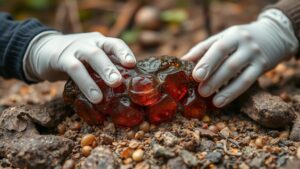Opal Fossil Hybrids: A Rare Look at Nature’s Colorful Fusion
Opal Fossil Hybrids: A Rare Look at Nature’s Colorful Fusion
For rockhounds and mineral collectors, few specimens captivate the imagination like opal fossil hybrids. These rare geological wonders showcase a striking marriage between organic and inorganic material, producing unique displays of color and texture that are a testament to natures creativity. This article delves into the formation, characteristics, and collecting of opal fossil hybrids, providing valuable insights for enthusiasts seeking to add these fascinating pieces to their collections.
Understanding Opal Fossil Hybrids
Opal fossil hybrids occur when opal forms within fossilized organic materials, such as wood or shells. This process begins when the original organic material is buried, preserving it in sediment. Over time, silica-rich groundwater infiltrates the fossil, replacing organic material with opal. This natural process can take thousands to millions of years, resulting in stunningly colorful specimens.
The Formation Process
The formation of opal fossil hybrids can be broken down into several distinct stages:
- Burial: The original organic material, like wood, becomes buried under layers of sediment.
- Silica Infiltration: Silica from groundwater seeps into the organic remains, starting the replacement process.
- Opal Formation: Over time, silica crystallizes into opal, capturing color play and structural patterns from the original material.
This whole process exemplifies a remarkable interplay of geology and biology, showcasing how two seemingly unrelated materials can unite over geological timescales.
Characteristics of Opal Fossil Hybrids
One of the most fascinating aspects of opal fossil hybrids is their diverse range of colors and patterns. opalescence seen in these fossils results from the microscopic arrangement of silica spheres, which refract light to produce a spectrum of colors. Key characteristics include:
- Color Variability: From vibrant blues to fiery reds, the color of opals can vary dramatically, influenced by the type of fossilized material.
- Patterns and Textures: Each hybrid is unique, often retaining the original texture and patterns of the fossilized material, such as bark layers in petrified wood.
- Transparency and Opulence: Some hybrids may display transparency, allowing a glimpse of the underlying structure, whereas others may be opaque and richly colored.
Significance in Geology and Collecting
Opal fossil hybrids hold significant value both scientifically and for collectors:
- Scientific Importance: These hybrids provide insights into past environmental conditions and the processes of fossilization, helping geologists understand ancient ecosystems.
- Collectors Treasure: Rarity and beauty make opal fossil hybrids highly sought after in the mineral collecting community. Experts suggest that high-quality specimens can sell for hundreds to thousands of dollars, depending on their size, color, and clarity.
Practical Tips for Collectors
For those interested in expanding their collections with opal fossil hybrids, here are some practical tips:
- Research Sources: Look for reputable dealers who specialize in unique fossils and minerals. Online marketplaces, gem shows, and rockhounding clubs can be great resources.
- Assess the Quality: Pay attention to the clarity and color intensity. High-quality specimens will display vibrant colors and minimal inclusions.
- Understand the Market: Familiarize yourself with market trends. Prices can fluctuate based on rarity and demand, so being informed can help you make wise purchases.
Caring for Your Collection
Once youve acquired opal fossil hybrids, proper care is essential:
- Storage: Keep them in a cool, dry place away from direct sunlight to prevent fading and damage.
- Handling: Always handle with care to avoid scratches; consider using gloves when necessary.
- Documentation: Keep a record of where and when each specimen was obtained, which can add to their value over time.
Conclusion
Opal fossil hybrids are more than just stunning collectibles; they represent a unique blend of biology and geology, offering insights into Earths history. From their fascinating formation processes to their captivating beauty, these hybrids provide rockhounds and collectors with a rare glimpse into natures artistry. By understanding their characteristics and care, collectors can enjoy these remarkable specimens while contributing to the appreciation and preservation of natural history.



